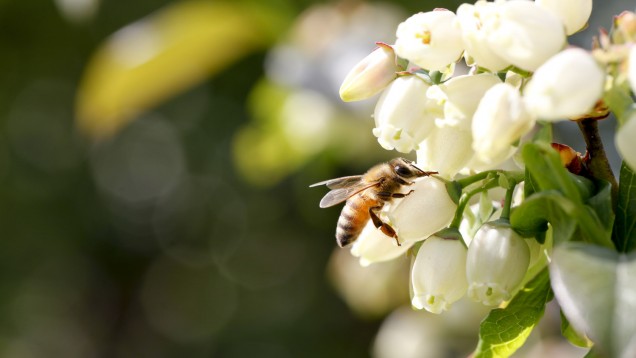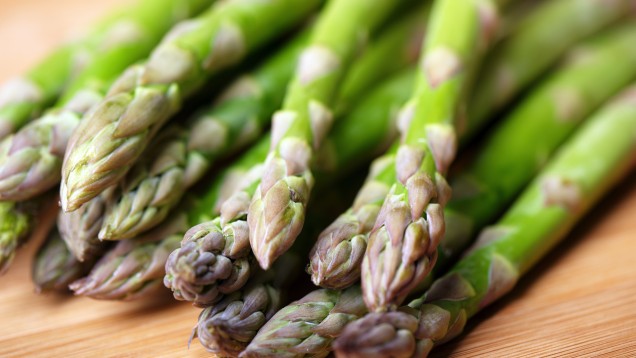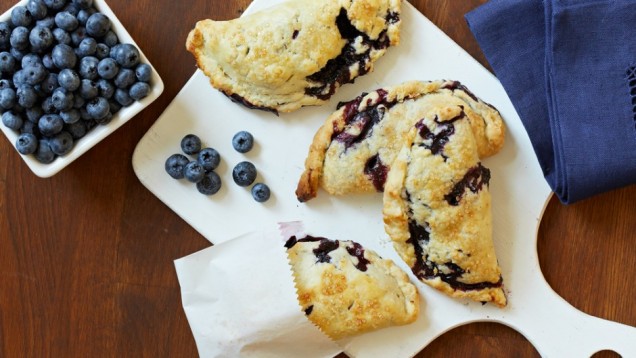
All a-buzz: how BC’s honey industry and blueberry farmers make a sweet mix
May 16, 2016
Spring has sprung and the province is in full bloom. For BC’s blueberry farmers, spring blossoms are a serious business: that’s when they partner up with local beekeepers to get the best out of our blueberry crop. To find out more about BC’s bees, we talked to Kerry Clark, President of the BC Honey Producers Association. And to learn about the blueberries our bees help grow, we chatted with Debbie Etsell, Executive Director of the BC Blueberry Council. Find out how BC’s honey bees support your favourite fruits, and check out some sweet recipes this team-up has to share!
We Heart Local: Can you both tell us a little bit about how bees and fruit/veggie growers work together?
Kerry Clark: Virtually every kind of fruit and berry produced – plus many nuts and most of the seeds for vegetables – require pollination, mostly by bees. Honey bees are the bees that are most able to be managed or brought to a farm that needs pollination.
Debbie Etsell: Without pollination our blueberry crop would not be as high quality. It tends to be a tougher job without bees – and if we have bees, the fruit tends to be a uniform size, which we all like to see in the stores!
WHL: Wait – how do bees help the fruit become a uniform size?
DE: If pollination has been effective, all the berries on the cluster will be around the same size. If there are no bees in the field, then you’ll have small to large ones – so there will be a variance in the blueberries.
WHL: That’s amazing! Kerry, what about the honey these bees go on to produce – what makes it special?
KC: BC honey has a great reputation as genuine and pure, and many people value the fact that it is produced in their own community. There are many distinct varieties of honey and endless subtle flavor differences. A taste of local honey can bring back memories of a warm summer’s day with the fragrance of blossoms in the breeze.
WHL: Can you tell us a little bit about what a year looks like for a beekeeper?
KC: In April, bees across the province gather protein-rich pollen from early blooms like willows and maples. They feed that pollen to baby bees and the population increases. Soon, bee colonies in the south may be ready to divide: some beekeepers make extra colonies for sale to new or other beekeepers. Late spring is a busy time for pollination: lots of moving of hives to berry fields to set the fruit. A little later there will be orchards to be pollinated, especially in the Okanagan. By mid-summer there will be a time when many, many blossoms are available: we call that a honeyflow, and the big healthy colonies are able to gather much more honey than they will need for the next winter. That surplus honey is what we can harvest from June through September. If we don’t give the bees extra room to put the honey, the hive may become too full and the bee colony could divide (that’s what we call swarming). But if we give them lots of room to grow, they just gather excess honey. By October, beekeepers remove the extra boxes of honeycomb and leave the bees with all they will need to keep themselves well fed and warm til the next spring. Through the winter they are on their own. There is nothing we can do to help while the weather is below freezing. Well fed, healthy bees snuggle together in a cluster inside the hive and vibrate to keep themselves warm. Around January, they somehow sense that spring is coming and start to raise young bees, and the cycle starts all over again.
WHL: What about blueberry producers, Debbie? How are they getting ready for blueberry season?
DE: Right now, we do a crop call every week across North America, and we report on pollination – (in fact) we reported today that we’re anticipating our crop to be coming around June 22nd this year. In a normal year, we’re somewhere around the beginning of July. Blueberry season usually goes into October, but when we start this early we’ll probably be into September sometime.
WHL: Are there parts of BC that are blueberry producing regions?
DE: Yes. Richmond is the place where it all started in the early 1900’s: it’s such an ideal location to grow blueberries. The main areas are up between Richmond and Chilliwack, and there are some places on Vancouver Island (as well as) in the interior. However, 97% of highbush blueberry production for all of Canada is set within that area of Richmond to Agassiz. We did 170 million pounds last year – that makes us the largest growing region of highbush blueberries in the world!
Getting your paws on BC honey and blueberries isn’t hard to do, and they pair perfectly with loads of summer dishes. Below, Kerry Clark generously shared his favourite ways to enjoy BC honey:
Starter Guide to BC Honey:
In the mood to enjoy a taste of honey? Let these tips be your starter guide! Kerry Clark says: “Honey doesn’t require any processing. It’s simply removed from honey combs and put in containers. It’s “in season” year-round and can last for years (though the delicate flavors are best within 2 years). Some honeys will granulate faster than others, but all can be re-liquefied by gentle heating. Natural honey has no gluten, cholesterol or sodium.”
- Use honey in any recipe that calls for a sweetener and any liquid. Honey is almost 1/5 moisture, so for every cup of honey, reduce the liquid in the recipe by 1/5 of a cup, or 50 ml.
- Warm honey and butter until both are soft, then blend (with a knife or blender) one part butter to a half part honey. Enjoy with biscuits, pancakes, bread or vegetables.
- Salad dressing: put equal parts oil (canola, olive or other) and cider vinegar in a jar with a tight fitting lid, with honey to taste (start with 1 tablespoon to a cup). Add chopped herbs, garlic, poppy or sesame seed etc. to suit your menu or yourself. Put on the lid, shake well and enhance the flavour of any salad.
Looking for more summer flavours? To see our updated (and delicious) index of blueberry recipes, head to our Recipe search, and enter the term “blueberry”!

